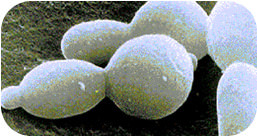8.10 菌类复制
章节大纲
-
How do fungi reproduce? Sexually or asexually?
::真菌怎么繁殖 性还是性?How about both? That would suggest that can produce both diploid and haploid , which they can. Shown above are fungi hyphae and haploid spores. Spores allow fungi to reproduce through unfavorable conditions.
::两种情况如何?这说明它们既能生产薄荷,又能生产薄荷。上面显示的是真菌的脑膜和薄荷的螺旋。 Spories允许真菌在不有利的条件下繁殖。Reproduction of Fungi
::复制真菌The majority of fungi can reproduce both asexually and sexually. This allows them to adjust to conditions in the environment. They can spread quickly through when conditions are stable. They can increase their through when conditions are changing and variation may help them survive.
::大部分真菌既可以性繁殖,也可以性繁殖,这样可以适应环境条件,在条件稳定时可以迅速传播,在条件变化时可以增加,变异可以帮助他们生存。Asexual Reproduction
::性生殖Almost all fungi reproduce asexually by producing spores. A fungal spore is a haploid cell produced by from a haploid parent cell . It is genetically identical to the parent cell. Fungal spores can develop into new haploid individuals without being fertilized.
::几乎所有的真菌都通过生产螺旋而性繁殖。 真菌卵子是一种由杂交母细胞生成的杂交细胞。 它在遗传上与母细胞完全相同。 真菌卵子可以发展成新的杂交个体,而不会受精。Spores may be dispersed by moving , wind, or other organisms . Some fungi even have “cannons” that “shoot” the spores far from the parent organism. This helps to ensure that the offspring will not have to compete with the parent for space or other resources. You are probably familiar with puffballs, like the one in Figure . They release a cloud of spores when knocked or stepped on. Wherever the spores happen to land, they do not germinate until conditions are favorable for growth. Then they develop into new hyphae .
::传动、 风或其他生物可能分散着。 有些真菌甚至有“ 罐子” , “ 射出” 离母体更远的螺丝。 这有助于确保后代不必与母体竞争空间或其他资源。 你可能熟悉浮球, 如图中的浮球。 它们敲击或踩踏时会释放出一团云。 无论它们在哪里降落, 它们不会发芽, 直到生长的条件有利。 然后它们会发展成新的螺旋。Puffballs release spores when disturbed.
::排气球在受到干扰时会释放颗粒Yeasts do not produce spores. Instead, they reproduce asexually by budding . Budding is the pinching off of an offspring from the parent cell. The offspring cell is genetically identical to the parent. Budding in yeast is pictured in Figure .
::酵母不会产生螺旋,相反,它们会通过发芽产生性生殖。 发芽是指从母细胞中抓取后代。 后代细胞在遗传上与母细胞相同。 图中显示了酵母中的发芽情况。Yeast reproduce asexually by budding.
::Yeast通过萌芽性繁殖。Sexual Reproduction
::性生殖Sexual reproduction also occurs in virtually all fungi. This involves mating between two haploid hyphae. During mating, two haploid parent cells fuse, forming a diploid spore called a zygospore . The zygospore is genetically different from the parents. After the zygospore germinates, it can undergo , forming haploid cells that develop into new hyphae.
::几乎所有的真菌中都存在性生殖,这涉及两条短裤间交配。在交配期间,两条短裤双胞胎双胞胎的母体导火线,形成一种叫作zygospore的双胞胎。zygospore在基因上与父母不同。在zygospore细菌后,它可以经历,形成可发展成新Hyphae的短裤细胞。Summary
::摘要-
The majority of fungi can reproduce both asexually and sexually. This allows them to adjust to conditions in the environment.
::大部分真菌既可进行性繁殖,也可进行性繁殖,从而使它们能够适应环境条件。 -
Yeast reproduce asexually by budding. Other fungi reproduce asexually by producing spores.
::其它的真菌则通过生产种状物来进行性繁殖。 -
Sexual reproduction occurs when spores from two parents fuse and form a zygospore.
::当父母双亲的螺丝破裂并形成zygospore时,即发生性生殖。
Review
::回顾-
Explain the advantages of fungal spores.
::解释真菌螺的优点 -
Identify ways that fungal spores may be dispersed.
::找出传播真菌螺子的方法 -
Compare and contrast a fungal spore and zygospore.
::比较和对比一个真菌和zygospore。
-
The majority of fungi can reproduce both asexually and sexually. This allows them to adjust to conditions in the environment.


